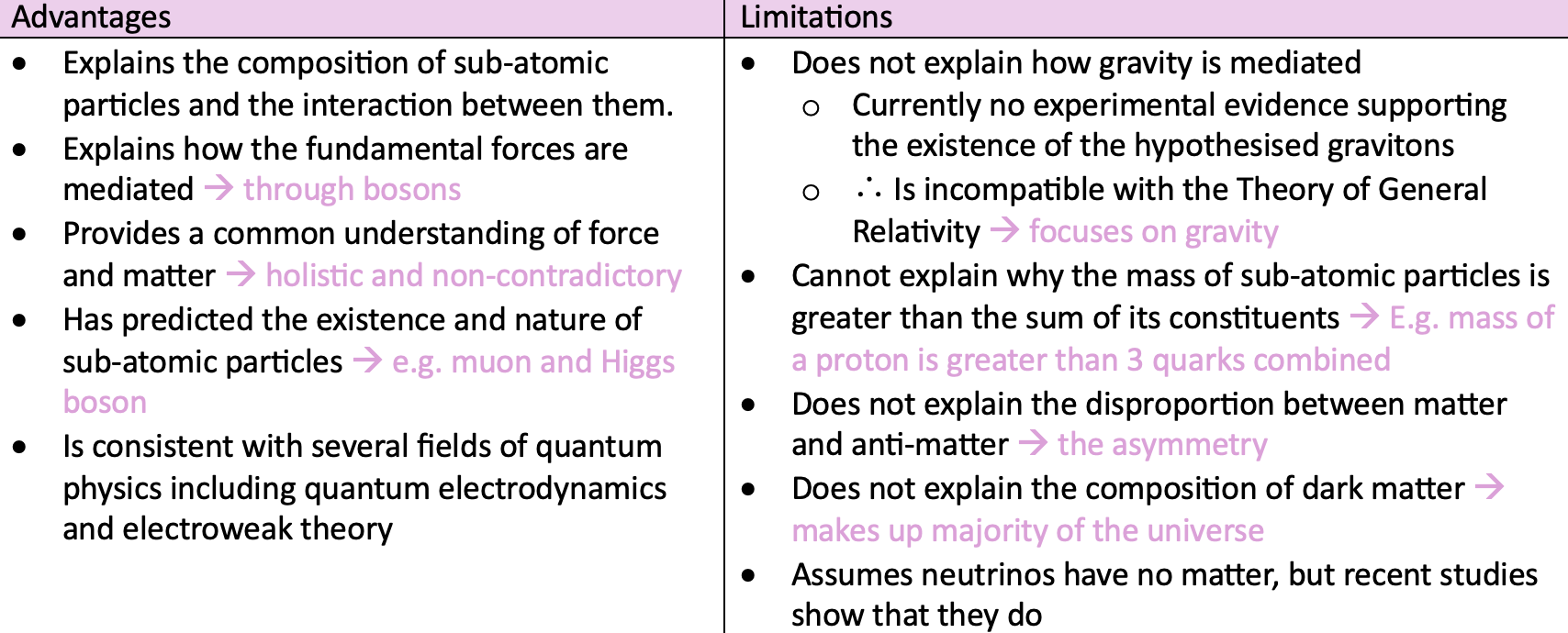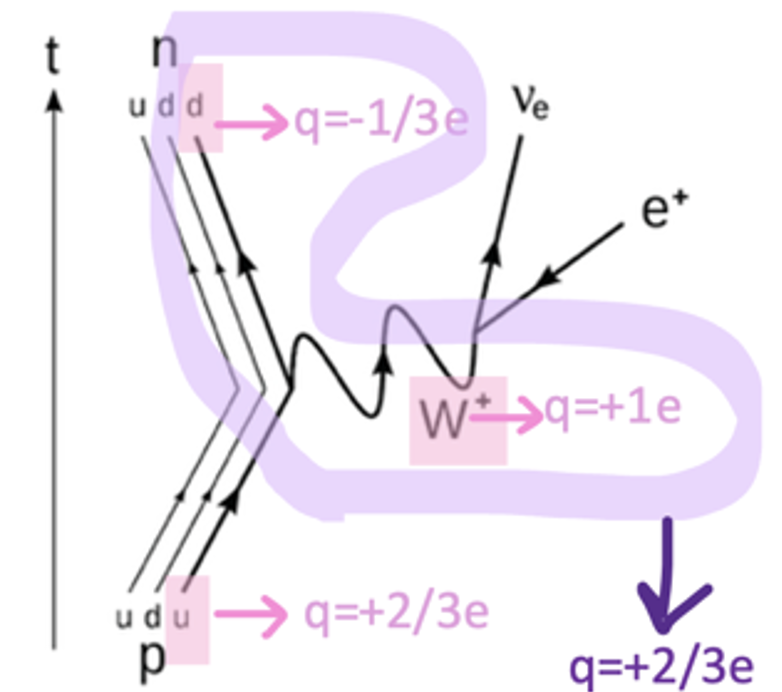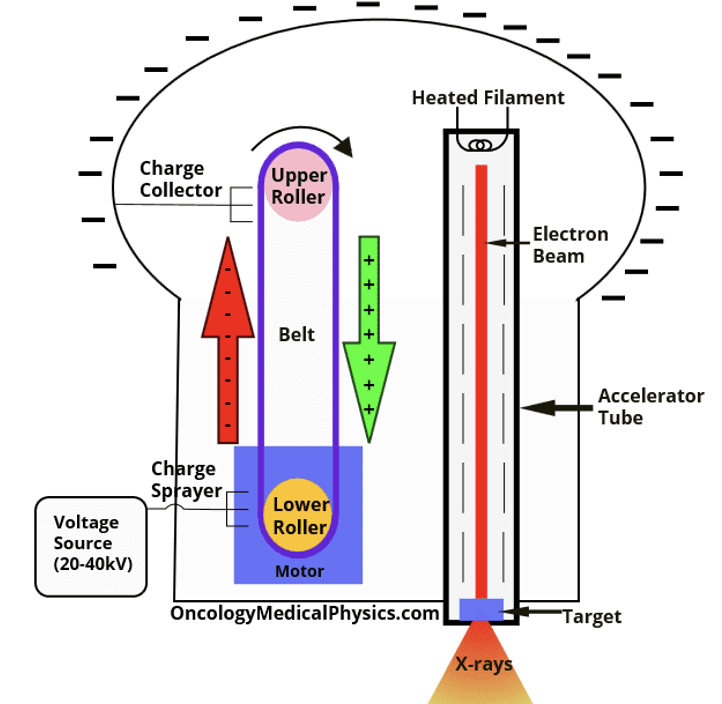Deep inside the Atom
1/29
There's no tags or description
Looks like no tags are added yet.
Name | Mastery | Learn | Test | Matching | Spaced |
|---|
No study sessions yet.
30 Terms
evidence that suggests that protons and neutrons are not fundamental particles
Deep Inelastic Scattering
Location: At SLAC (Standford Linear Accelerator)
Method:
Liquid hydrogen was kept at a very cold temperature kept protons close together
Electrons were accelerated using electric fields towards the hydrogen
The scattering angle of electrons that hit the hydrogen were detected using a detector
They knew the momentum and velocity of the scattered electrons by measuring their curvature in a magnetic field
Hypotheses:
The electron’s wavelength is small enough, it can penetrate the proton
If proton has nothing inside, the electron that passes through will not lose much kinetic energy = elastic scattering will occur
If the proton consists of subatomic particles, the electron will collide with them and lose kinetic energy = inelastic scattering will occur
Deep inelastic scattering
Results:
Result showed deep inelastic scattering
Scattering patterns were identified as being caused by particles inside the protons
Sometimes the electrons caused the proton to shatter and hadronization to occur
Where quarks and gluons were emitted out of protons
Caused other hadrons, like pions, to be created
Demonstrated that the proton was not a fundamental particle
Neutrons
The same process occurred for neutrons, showing that they were not fundamental particles
the existence of subatomic particles other than protons, neutrons and electrons
Muon discovery
Discovered by Anderson and Neddermeyer while studying comic radiation
Cosmic rays originate as primary cosmic rays
Formed due to various astronomical processes
Primary cosmic rays are composed of alpha particles and a small proportion of heavier nuclei (<1%)
Primary cosmic rays decay into secondary cosmic rays.
Secondary cosmic rays consist of sub-atomic particles
E.g. photons, leptons, hadrons (protons and neutrons), electrons, positrons, muons and pions.
A magnetic field was applied in the cloud chamber containing cosmic radiation.
Field interacted with molecules in chamber
Sub-atomic particles were produced from cosmic rays
This released a particle with a deflection trail similar to an electron
Same direction (negative charge)
Less deflected → Radius was bigger (larger mass, assuming same charge of -1)
Was later confirmed muons are 200x heavier than electrons.
Were initially thought to be mesons but since they do not interact with gluons (strong force), they are leptons
the existence of subatomic particles other than protons, neutrons and electrons
Electron neutrino discovery
Initially, it was thought that only the beta particle was emitted during beta-decay
Due to mass difference between products and reactants, we can calculate these particles are meant to have
The energy absorbed by the beta decay products of radium was measured
Ejected electrons heated up water surrounding radium
Used change in temperature to calculate energy absorbed
Results showed that the energy absorbed was lower than the calculated energy using the mass defect and E=mc²
The total energy released could not be accounted for by the energy of the beta particle
This violated the law of conservation of energy
Pauli proposed that there must be another particle emitted with the beta particle that carries the “missing” energy
Particle must have a small mass and not interact much with surroundings (neutral, highly penetrating)
Existence was confirmed in 1931 in nuclear fission reactions named the (electron) neutrino
Standard Model of Matter
describes the fundamental particles of matter + their interactions
Consists of two major types of fundamental particles, each with different flavours
Matter particles (fermions: leptons and quarks) and force-carrier particles (bosons)
6 flavours of leptons
no colour
6 flavours of quarks, which make up hadrons (mesons and baryons)
Each quark could have one of three different colours (red, green and blue)
5 flavours of bosons
Can also possess colour, except Higgs boson
All leptons and quarks have a corresponding antiparticle, with the same mass but opposite charge
Antimatter = same mass but opposite charge
Note: does NOT describe gravity
Evaluation of the standard model

Quarks
combine to make other particles → cannot exist in isolation
Matter particles
Experience all four fundamental forces
There are six flavours of quarks, grouped into three generations.
First generation: up and down (lightest, most stable, most abundant)
Second generation: charm and strange
Third generation: top and bottom (heaviest, rarest, least stable & decay into 1st gen)
Have fractional electric charges
Up, charm, top: +2/3e
Down, strange, bottom: -1/3e
Antiquarks are the antiparticles to quarks → same mass but the opposite charge

Hadrons
particles made from a combination of quarks
All hadrons must be colour neutral colour of quarks combine to make white
Red + green + blue = white
Colour + anti-colour = white (e.g. red + anti-red)
Quarks are held together by gluons, which also have colour
Must have integer charge
two types: baryons and mesons
Baryons
Consist of three quark/antiquark particles.
Protons (uud)
Consists of two up quarks (uu) and one down quark (d)
Total charge = +1e
Neutrons (udd)
Consists of one up quark (u) and two down quarks (dd)
Total charge = 0e (neutral)
Lambda (Λ) particle (uds)
Up, down and strange quark
Total charge = 0e
Heavier than a proton
Unstable and decays into
A negative pion and a proton
A neutral pion and a neutron
Mesons
Consist of one quark and one anti-quark.
Pions are down to play, but not kaons since they are strange
Positive pions, 𝜋+ (ud̄)
Consists of one up quark and one antidown quark
Total charge = +1e
Negative pions, 𝜋- (ūd) → antimatter of 𝜋+
Consists of one antiup quark and one down quark
Total charge = -1e
Neutral pions, 𝜋0 (dd̄, uū) → VERY unstable (decay into gamma rays)
Consist of either
A down and an antidown quark
An up and an antiup quark
Quantum superposition
Total charge = 0e
Positive kaon, K+ (us̄)
Consist of up and anti-strange particle
Total charge = +1e
Negative kaon, K- (ūs) → antimatter of K+
Consist of antiup and strange particle
Total charge = -1e
pions are formed during proton and antiproton collisions
Leptons
Matter particles
Does not experience all fundamental forces
Do not have colour = cannot feel strong force = cannot be held in nucleus
Leptons don’t make up larger particles
Neutrinos are neutral = cannot experience EM force
Have three generations, dividing them into pairs
First generation: electron and electron neutrino (lightest)
Second generation: muon and muon neutrino
Third generation: tau and tau neutrino (heaviest, most unstable, decay into 1st gen)
Are integer multiples of elementary charge (0 or -1)
Obey Pauli’s Exclusion principle
Leptons have corresponding anti-leptons
Note: antimatter for electron is positron

Bosons
Force mediating/carrier particles
Bosons mediate the forces and interactions between quarks and leptons
Bosons and their forces have different relative strength and range of influence
E.g. In a proton, the up quarks repel each other, but since the gluons are stronger than the photons at that small range, they remain together
Types
gluon
photon
W±, Z
Higgs (noone gaf)
Gluons
Mediates the strong force (in nucleus of atoms)
Force between quarks
Glues them together to form hadrons
Allows interactions with different nucleons as well
Only effective in a short range (1fm)
Massless
Photon
Mediates the electromagnetic force
Force between charged particles
Electromagnetism is due to virtual photons being transferred between charged particles → e.g. electrostatic repulsion is due to protons exchanging virtual photons
Virtual particles pop in and out of existence, due to Heisenberg’s uncertainty principle
Act over an infinite range
Massless
W and Z Bosons
Mediates the weak force
Responsible for the flavour and charge changes of particles
e.g. quark/radioactive decay, neutrino oscillations, electron capture to make a proton a neutron, annihilation
Allows quarks and leptons to interact
Act over a short range → these bosons are unstable and decay
Have mass and are relatively heavy
W+ and W- are the only bosons to have charge
W+ bosons
q=1e
Mediate beta-plus decay → allows charge to be conserved
An up quark in a proton is converted into a down quark
Causes the proton to become a neutron
Produces a positron and electron neutrino conservation of lepton number

W- Bosons
q=-1e
Mediate beta-minus decays allows charge to be conserved
A down quark in a neutron is converted into an up quark
W- boson allows charge to be conserved
Causes the neutron to become a proton
Produces an electron and electron antineutrino
Z0 bosons
q=0e
Facilitating neutral current interactions → exchange energy but not change charge
Responsible for transferring momentum
E.g. High energy annihilation between electron and positron produces a Z boson which quickly decays to form a muon neutrino and muon antineutrino.
Higgs Boson
They have no direction (scalar), no charge, no spin BUT DO have mass.
Was predicted before its discovery in a particle accelerator (Large Hadron Collider) in 2013
The Higgs field (provided by the Higgs boson) accounts for the mass of W and Z bosons
Types of Particle Accelerators
linear
cyclotron
synchotron
Linear accelerators (LINAC)
uses electric fields to speed up tarticle
A charged particle travels through segments (tubes) alternately polarised by AC power source
When the particle travels through each charged tube, the polarity of the next tube changes
∴ An electric field is present between adjacent tubes
When the particle travels through the gap of the tubes, the electric field created accelerates it
The length of each successive tube increases further along to accommodate for the particle’s increasing speed
Want to spend the same amount of time in each tube, so that the frequency of the AC power aligns with when the particle leaves the tube
allows particle to accelerate
Increased velocity = increased distance for same time
Examples: SLAC

Van de Graaf accelerator
A belt rubs off electrons from the surrounding conductor
As it moves along, it becomes neutralised by the spray supply, so that it can keep removing electrons
This makes conductor increasingly positive
This pushes positive ions down the accelerator tube

Cyclotrons
Two hollow D shaped structures called the ‘dees’
Dees are separated by a gap
An electric field is created in the gap by a potential difference
When the charged particle travels across the gap from one dee to another, electric field accelerates it
Polarity changes to allow the particle to accelerate to the other dee when it turns around
Magnetic fields are present in the two dees
Particles undergo UCM in magnetic field
The particle follows an outwards spiral path
Electric field accelerates it = increased velocity
Increased velocity = increased radius when in magnetic field (r=mv/qB)
Synchrotrons
Contain a LINAC = accelerates the charged particle from rest
When the charge starts moving, it enters the booster ring
Electric and magnetic fields that accelerate the particle further in a circular motion
Electric fields = increase speed
Magnetic fields concentrated to specific areas = changes its direction to follow a circular path (not a spiral)
Synchronised with particle speed to keep its radius of UCM constant
Also accounts for increased relativistic momentum to keep radius the same
After a specific speed reached = particle enters the storage ring
Acceleration produces EM radiation (synchrotron light)
Example: The Hadron Collider
Summary of particle accelerator types

Role of Particle Accelerators
By accelerating particles to very high speeds, various concepts in physics can be tested, verified and predictions can be made.
standard model
detect and investigate fundamental particles
create new particles
big bang
model conditions
special relativity
Time Dilation
Length Contraction
Relativistic momentum and mass
Evidence for the standard model
Detecting and investigating the nature of fundamental particles
JJ Thomson’s Charge to Mass Ratio Experiment (electrons)
Cathode ray tube containing both electric fields accelerate electrons into a region of perpendicular magnetic and electric fields
He calculated their q/m by changing the strength of these fields so that the electron would not be deflected
FE = FB = FB ∴ q/m = E/B2r
Proved the existence of the electron
A type of lepton, Spin of ½
Charge of -1e as determined by Millikan
Showed they were in all atoms since there were emitted by cathodes of all elements
High energy electron-proton Collisions (quarks)
Electron is accelerated into a proton, causing it to emit quarks and for hadronization to occur
Called deep inelastic scattering
Shows that protons were not fundamental particles but a type of baryon (hadron to be specific)
Made up of two up quarks and a down quark
Spin of ½, Charge of +1e
Electron-positron collisions allowing us to prove the existence of gluons
Used particle accelerators to accelerate electrons and positrons at each other
Annihilation would occasionally generate a gluon and a quark-antiquark pair
Allow us to observe the nature of force carrier particles and their interactions
Particle accelerators allowed physicists to test nature of gluons
Discover it mediates the strong force and keeps quarks together to form hadrons
Evidence for the standard model
The creation of new particles (particle zoo)
Particle accelerators use electric fields to accelerate charged particles
The Large Hadron Collider (synchrotron) also uses magnetic fields for the synchrotron/cyclotron to confine the particle
The SLAC (linear accelerator)
Increases their kinetic energy
Allows new, heavier particles to be created via E=mc2
New particles (e.g. Pions, Kaons) to be observed makes up the particle zoo we know today
Their properties can only be explained using the standard model
Mesons – consist of a quark and antiquark
Baryons – consist of three quarks held together by gluons
Particle accelerators Evidence for the Big Bang
Used to model early conditions of the Big Bang
Early periods (e.g. inflation and post inflation) had extremely high temperatures which we can model using particle accelerators
Can simulate the high energy situation and cause matter and antimatter to be created from energy → via E=mc²
After expansion of singularity (inflation period)
Initially only unstable fundamental particles like quarks and leptons were made (post inflation)
Over time = more cooling as universe expands further → allows quarks to join using gluons to form protons and neutron
More time: nuclei created due to residual strong force → neutral atoms created via EM force mediated by photons → matter decouples from energy and releases IR radiation →over time atoms gather together due to gravity to form heavier atoms, then stars, planets and galaxies
Reveals how matter was created after the singularity and how that evolved into the universe we see today
Note: This method is not successful in showing why the symmetry between matter and anti-matter production was broken during early stages of the Universe
Evidence for special relativity
Time Dilation
We can accelerate unstable particles (e.g. muons)
They last a longer time in the Earth’s FOR than they normally would (we are experiencing the dilated time)
E.g. muons are a second generation of lepton with a lifespan of 2.2 microseconds
Too short for us to test them
By accelerating them to near light speeds using particle accelerators, relativistic effects take place due to einsteins second postulate of special relativity
For speed of light to be kept constant, length and time are relative
Increases lifespan of muon in FOR of earth = means that the length of path travelled is contracted for the muon
Allows us to determine its properties like its charge (-1e), mass (heavier than an electron) and its interactions with other particles (e.g. muon, anti-muon annihilation)
Length Contraction
In the particle’s FOR, its lifetime is still short
Length contracts so that they can travel through space further than the normally could without relativistic effects
Relativistic momentum and mass
When it is travelling at high speeds, the momentum of the particle increases due to its observed mass increasing
Makes it harder to accelerate since the work done goes in to increasing the relativistic mass